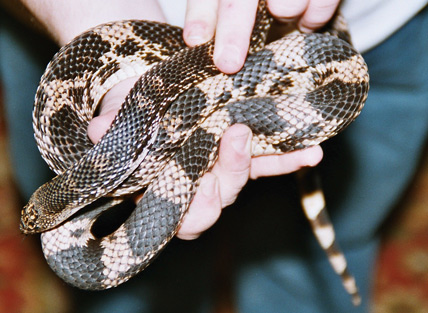|
Distribution |
|
The pine snake lives in the eastern USA in parts of New Jersey to the north of Georgia and Alabama in the south. The distribution area is strongly separated. There are enclaves f.e. in New Jersey and Virginia. Furthermore south it lives in parts of Nord- and South Carolina, Georgia, Kentucky, Tennessee and north Alabama. With the florida pine snake they have intergradezones in central Georgia and in central South Carolina.
|
|
Description |
 |
The primary color of this firm snake is a white tone usually which can go particularly (but not only) in the southern distribution area also into brownish, yellowish, light grey or reddish. On the back of the body there are about 25 to 32 saddle markings, the tail has about 5-8 spots. The color of the saddles starts in the neck with black and becomes in the back part of the body usually brown till reddish brown. Particularly beautiful colored animals e.g. come from New Jersey and have black saddels throughout on white ground. In the same area a seldom form with red ground color occures.
A number of faded black spots are on the side of the body. The belly is whitish with black markings.
The average lengh is about 1,5-2 m, the maximum is at about 2.5 m.
|
The scales are keeled. In the middle of the body there are more than 27 scale rows, mostly it are 29-31. Specialyties in head scalation: 4 scale in front of the eyes (Präfrontalia). The snout scale is higher than broad (Rostrale - Nasale 1:1,5). There were found seldomly amelanistic animal in the field. Those animals have white saddles on partly pure white ground. Too, there occure yellow to orange ground colors.
|
|
|
|
Habitat |
|
Sandy pine woods and dry shaly ridges the pine snakes live in, rarer are sights in old farm land. They avoid damp areas. The snake can dig good and lives often in rodent tunnels. Sometimes it klimbs on trees, but mostly for searching food in birdnests. They occure in heights mostly below 100m, very seldom you can find them in hights up to 700m.
|
|
Way of life |
|
This snake is mostly durinal. The distribution area is strongly separated. This is connected with it's preferential habitats and the food. Lumbing and other habitat destruction are more and more reducing the area of the pine snake. Furthermore road impact reducing their populations. They are protected in many states of its distribution. Pine snakes spend much time in tunnels of the pocket gophers, their main food. However, the snakes can dig in the sand also quite well, her particularly formed rostal scale helps with this. Nestingplaces and hibernacula are dug or improved so newly.
|
|
Diet |
|
In the habitat those snakes mainly eat pocket gopher. Furthermore they sometimes eat some rodent sorts up to the size of semiadult rabbits, enriched with birds and their eggs.
|
|
Hibernation |
|
The durination of hibernation varies depending of ist distributon. Partly it hides in September and is seen again after hibernation in next April.
|
|
Reproduction |
|
The mating periode begins after the hibernation mostly in May.
Aprox. 8 weeks after the succsessful mating the female lay in June/July a clutch of 4-24 eggs. The lenght of the eggs is between 4,5 and 7cm, the diameter is 2,5 to 4,5cm.
The female prefers sunny, sandy areas with few plants. There it digs a hole, improve a rodent tunnel ore take a prooven egglaing place. The Northern pine snakes often use those prooven egglaying places, mostly with more than one female.
In August/September the small snakes hatch. Then they have an av. lenght of 35 to nearly 50cm.
Their coloration mostly resembles the parents, most of the saddles are seperated. The coloration changes a little in growing, the saddles can change their form and color and connect each other in the neck.
|
|
Keeping in terrarium |
|